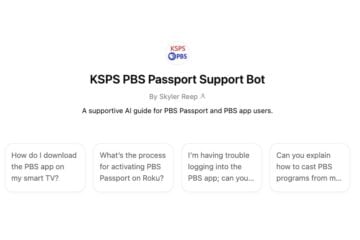How nonprofit news outlets are using AI to save time and money

Birdlkportfolio / iStock
This article is republished here with permission from the Institute for Nonprofit News.
About a third of nonprofit news outlets are using artificial intelligence to benefit their organization, according to survey data from the Institute for Nonprofit News’ annual Index survey. By this time next year, this AI-using cohort will likely grow to more than half of the sector.
Today, drafting fundraising emails, scraping databases, translating stories and aggregating links in newsletters are just a few ways nonprofit news outlets are using AI.
Much is unclear about how AI will continue to impact the journalism industry, but one thing is evident: AI is here to stay. There’s an opportunity for outlets to leverage some AI tools now to save time and make money.
At the same time, nonprofit news organizations must maintain a high ethical standard by ensuring this technology is used responsibly and transparently, while also prioritizing data privacy. Maintaining our audiences’ trust and upholding journalistic integrity while using these new technologies will be one of the biggest challenges of our time.
Outlets can start by defining guidelines for using AI in their workplaces. Many outlets in our survey, for example, prohibit AI use when conducting interviews or writing stories. INN doesn’t have AI policy recommendations, but NPR and PBS standards are a good place to start. A cohort of news organizations are documenting audiences’ perception of AI use in newsrooms, with more findings slated for release at the Online News Association conference in September.
The following are popular uses of AI tools among nonprofit news outlets along with lists of frequently used tools. The right tools and how organizations use them are highly specific to individual teams, so this information is not meant to be endorsements.
Fundraising and donor management
INN members have found AI assistant tools useful for personalizing donor communications, identifying promising prospects and streamlining fundraising campaigns. Some tools could help outlets identify more engaged audiences and customize messages for them.
Grist, a large national outlet covering the climate, used AI during a spring fundraising campaign. The Grist team ran top-performing fundraising emails through ChatGPT with commands such as “Make this email more donor-centric” or “Is this a compelling email to increase reader donations?” Then a staff member rewrote the ChatGPT draft by adding relevant and recent content from Grist. Grist also uses AI to create first drafts of subject lines, preheader text and call-to-action messages on the Grist website.
Tools commonly used for fundraising:
Translation for accessibility and fundraising
Outlets are leveraging AI to translate their coverage into languages other than English to reach more audiences. For example, the New Bedford Light, a Massachusetts news startup, introduced an AI-based story reader and translator from Trinity Audio earlier this year. Trinity Audio allows readers to click an icon beneath the headline to hear an AI digital voice read the story in their native language. New Bedford Light uses a tier of the program that translates up to 200 stories per month into six languages: English, Spanish, Portuguese, French, Vietnamese and Arabic. The outlet selected those languages because they are spoken in local schools.
Arizona Luminaria, a statewide outlet publishing in Spanish and English, uses ChatGPT to help craft marketing and fundraising campaign messages. With ChatGPT, the team translates first drafts of fundraising pitches from English to Spanish before a human edits them.
The New Bedford Light, a Massachusetts-based news startup, uses the AI tool Trinity to offer audio versions of its stories in multiple languages.
Tools commonly used for translation work:
Data collection and analysis
AI is helping some nonprofit news outlets conduct more efficient in-depth investigations by automating some time-intensive tasks. For example, the Salt Lake Tribune partnered with Seer, a Utah-based company that uses AI to decode and summarize legislation. Seer ingests thousands of pages of bills into a large language model to produce summaries that clarify key provisions, facilitating journalists’ analysis and readers’ understanding of legislative content.
The Marshall Project, an outlet that focuses on criminal justice, uses ChatGPT along with close human review to summarize lengthy policy documents. The team uses the summaries to supplement a searchable database of books banned in prisons. Generative AI helps the Marshall Project team clean, analyze and understand criminal justice data that is often very fractured and opaque.
Digital Democracy, a new project at CalMatters, provides more transparency and coverage of California legislators. It uses new technologies to scrape data from government sources, create a searchable transcript of hearings or floor sessions and apply a custom AI tool to identify potential stories for reporters.
Tools commonly used for data analysis:
Audience engagement
Some nonprofit news outlets use AI tools to draft social media copy, translate and format stories for different platforms and make recommendations on the timing and frequency of messages.
Documented, an investigative watchdog journalism project, uses an in-house AI application to summarize and aggregate articles for their newsletter, Early Arrival. By spending less time on the newsletter summaries — a section Documented audiences use and enjoy — reporters can focus on newsletter data and analysis.
The Documented team is also developing AI technology to streamline efforts to keep 150 digital guides up to date. AI will monitor the published resources and alert the team when an update is necessary.
Tools commonly used for audience engagement:
Transcription, workflow optimization and administrative tasks
Nonprofit news outlets are integrating AI into their workflows to save time on administrative tasks.
Resolve Philly recently took inventory of AI transcription services its team uses and began using those options to take board meeting minutes. Its operations team is examining the AI concerns, such as protecting personally identifiable information and cybersecurity.
One local news outlet uses AI tools to transcribe internal meetings, generate minutes and summarize and outline the next steps. This has improved internal communication and coordination, helping the team maintain momentum and accountability across projects.
Tools commonly used for administrative tasks:
INN uses AI on behalf of membership through the design and build of two products: On the Ground and Text RURAL.
On the Ground is a local elections and politics republication service. It uses AI and machine learning (via Overtone) to aggregate and categorize members’ news reports about local politics and elections, summarize those stories using Nota AI tools and send them to newsrooms in a personalized email newsletter. Editors can select stories to republish and get all the story assets by email.
Text RURAL aims to make rural-relevant journalism more accessible by distributing it via text messaging. Text RURAL aggregates and summarizes stories from INN’s Rural News Network newsrooms and distributes them every Friday in a localized and personalized news roundup.
INN has also partnered with Nota to help small newsrooms access AI resources. Nota offers a suite of AI tools that reformat human-created content into multiple text, audio and video formats. Nota can help quickly generate headline ideas, pull key points from an article and generate video, social copy and newsletters. INN members can click here to get started with Nota.






